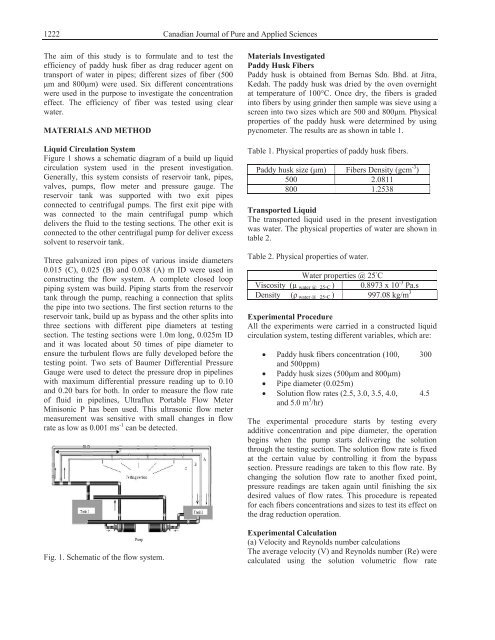Download (5Mb) - Covenant University Repository
Download (5Mb) - Covenant University Repository
Download (5Mb) - Covenant University Repository
Create successful ePaper yourself
Turn your PDF publications into a flip-book with our unique Google optimized e-Paper software.
1222<br />
The aim of this study is to formulate and to test the<br />
efficiency of paddy husk fiber as drag reducer agent on<br />
transport of water in pipes; different sizes of fiber (500<br />
µm and 800µm) were used. Six different concentrations<br />
were used in the purpose to investigate the concentration<br />
effect. The efficiency of fiber was tested using clear<br />
water.<br />
MATERIALS AND METHOD<br />
Liquid Circulation System<br />
Figure 1 shows a schematic diagram of a build up liquid<br />
circulation system used in the present investigation.<br />
Generally, this system consists of reservoir tank, pipes,<br />
valves, pumps, flow meter and pressure gauge. The<br />
reservoir tank was supported with two exit pipes<br />
connected to centrifugal pumps. The first exit pipe with<br />
was connected to the main centrifugal pump which<br />
delivers the fluid to the testing sections. The other exit is<br />
connected to the other centrifugal pump for deliver excess<br />
solvent to reservoir tank.<br />
Three galvanized iron pipes of various inside diameters<br />
0.015 (C), 0.025 (B) and 0.038 (A) m ID were used in<br />
constructing the flow system. A complete closed loop<br />
piping system was build. Piping starts from the reservoir<br />
tank through the pump, reaching a connection that splits<br />
the pipe into two sections. The first section returns to the<br />
reservoir tank, build up as bypass and the other splits into<br />
three sections with different pipe diameters at testing<br />
section. The testing sections were 1.0m long, 0.025m ID<br />
and it was located about 50 times of pipe diameter to<br />
ensure the turbulent flows are fully developed before the<br />
testing point. Two sets of Baumer Differential Pressure<br />
Gauge were used to detect the pressure drop in pipelines<br />
with maximum differential pressure reading up to 0.10<br />
and 0.20 bars for both. In order to measure the flow rate<br />
of fluid in pipelines, Ultraflux Portable Flow Meter<br />
Minisonic P has been used. This ultrasonic flow meter<br />
measurement was sensitive with small changes in flow<br />
rate as low as 0.001 ms -1 can be detected.<br />
Fig. 1. Schematic of the flow system.<br />
Canadian Journal of Pure and Applied Sciences<br />
Materials Investigated<br />
Paddy Husk Fibers<br />
Paddy husk is obtained from Bernas Sdn. Bhd. at Jitra,<br />
Kedah. The paddy husk was dried by the oven overnight<br />
at temperature of 100°C. Once dry, the fibers is graded<br />
into fibers by using grinder then sample was sieve using a<br />
screen into two sizes which are 500 and 800µm. Physical<br />
properties of the paddy husk were determined by using<br />
pycnometer. The results are as shown in table 1.<br />
Table 1. Physical properties of paddy husk fibers.<br />
Paddy husk size (µm) Fibers Density (gcm -3 )<br />
500 2.0811<br />
800 1.2538<br />
Transported Liquid<br />
The transported liquid used in the present investigation<br />
was water. The physical properties of water are shown in<br />
table 2.<br />
Table 2. Physical properties of water.<br />
Water properties @ 25 C<br />
Viscosity (µ water @ 25C ) 0.8973 x 10 -3 Pa.s<br />
Density ( water @ 25C ) 997.08 kg/m 3<br />
Experimental Procedure<br />
All the experiments were carried in a constructed liquid<br />
circulation system, testing different variables, which are:<br />
Paddy husk fibers concentration (100, 300<br />
and 500ppm)<br />
Paddy husk sizes (500µm and 800µm)<br />
Pipe diameter (0.025m)<br />
Solution flow rates (2.5, 3.0, 3.5, 4.0, 4.5<br />
and 5.0 m 3 /hr)<br />
The experimental procedure starts by testing every<br />
additive concentration and pipe diameter, the operation<br />
begins when the pump starts delivering the solution<br />
through the testing section. The solution flow rate is fixed<br />
at the certain value by controlling it from the bypass<br />
section. Pressure readings are taken to this flow rate. By<br />
changing the solution flow rate to another fixed point,<br />
pressure readings are taken again until finishing the six<br />
desired values of flow rates. This procedure is repeated<br />
for each fibers concentrations and sizes to test its effect on<br />
the drag reduction operation.<br />
Experimental Calculation<br />
(a) Velocity and Reynolds number calculations<br />
The average velocity (V) and Reynolds number (Re) were<br />
calculated using the solution volumetric flow rate

















